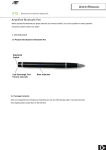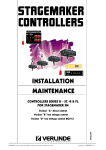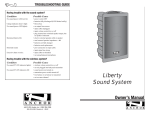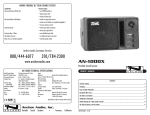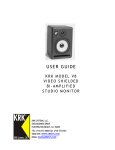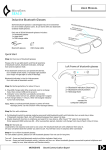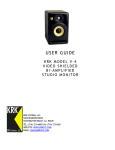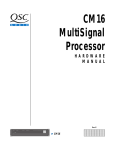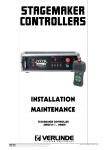Download 560-0032 SM-5 BLX User Guide REV A.indd
Transcript
Warranty statement. Sound Projections Six Year Limited Warranty. The Sound Machine SM-5 is warranted to be free of defects in materials and workmanship for a period of 6 years from the date of original purchase, subject to the following conditions: • This warranty excludes defects caused by normal wear, abuse, shipping damage or failure to use product in accordance with instructions. All warranty service must be performed or authorized by Sound Projections. Any service or modifications performed without authorization from Sound Projections may void this warranty. • The Lithium Iron Phosphate (LFP) rechargeable battery in SM-5 models is warranted for a period of 3 years. • Wireless microphone and CD/MP3 player options are warranted for a period of 2 years. • Prior to returning your system for repair and/or warranty service, please contact our customer service department at the address below for a Return Authorization (RA) number. Sound Projections 1815 W. 205th Street, Suite 103 Torrance, California 90501 (310) 618-9619 www.soundprojections.com 560-0032 Rev A, SM-5 12/13 User Guide Sound Machine SM-5 Welcome Replacing the fuse. Congratulations on purchasing a portable sound system from Sound Projections. Our products combine superior design with quality components and rugged construction. We’re proud of the products we manufacture, and appreciate the confidence you’ve shown by choosing us. Please take a few of minutes to read this user guide. Our products incorporate many unique features, and your knowledge of them will enhance the performance of your system. Warning! Replace fuse with same type and rating as indicated on panel. 1. Remove power cord plug from panel mounted AC receptacle John Munroe, President 2. Pry fuse carrier away from receptacle with small screwdriver and the entire staff at Sound Projections 3. Remove fuse to be replaced. install fuse 4. Install new fuse Unpacking 5. Insert fuse carrier with new fuse back into receptacle 6. Plug power cord back into AC receptacle System inspection and inventory. Check the unit carefully for damage which may have occurred during transit, and contact the freight carrier immediately should you find damage. Specifications for SM-5. Save the shipping carton and packing materials. Rated power output ................................................ 200 watts dynamic The shipping box was designed to ship your unit safely. Max SPL ................................................................. 127 dB ‘loud’ mode ................................................................................ 120 dB ‘normal’ mode Contents Frequency response ............................................... 65 Hz - 16 kHz Wireless system (optional) ..................................... Shure 123 channel auto-scan Safeguards 3 Battery life............................................................... 4-8 hours typical Getting started 4 Power requirements ............................................... 110/240 VAC - 50/60 Hz, 200 watts max Charging the battery 5 Dimensions (HWD) ................................................. 23 x 15 x 13” (58 x 38 x 33cm) Choosing an input 6 Wireless microphone operation 8 Wireless system set-up (channel frequencies) 11 Using talkover 13 CD operation (see separate instructions) Setting the EQ controls 13 Using outputs 14 Changing the fuse 15 Specifications 15 Warranty Statement 16 Weight .................................................................... 32 pounds (14.5 kg) without options ................................................................................ 35 pounds (16kg) with CD and 1 receiver Inputs ...................................................................... (2) mic level, balanced, XLR ................................................................................ (1) line level, balanced, XLR ................................................................................ (1) line level, 1/4” phone ................................................................................ (1) tape/CD level, dual RCA Outputs ................................................................... (1) line level, balanced, XLR ................................................................................ (1) line level, 1/4” phone ................................................................................ (1) tape/CD level, dual RCA ................................................................................ (1) speaker output Specifications and models subject to change without notice 2 15 Using the outputs. Important safeguards CAUTION AVIS L RISK OF ELECTRIC SHOCK DO NOT OPEN tape RISQUE DE CHOC ELECTRIQUE NE PAS OUVRIR R two one output Connect RCA outputs to a tape player’s input to record the sound system. The tape output is a line-level, summed and composite signal of the sound system inputs. line output Connect line output one to the balanced input of another system for daisy-chain applications. Line output one is a balanced, low-impedance and composite signal of the sound system inputs. Connect line output two to a tape player’s input to record the sound system. Line output two is an unbalanced, line-level and composite signal of the sound system inputs. CAUTION: To reduce the risk of electric shock, do not remove the cover. No userserviceable parts inside. Refer servicing to qualified personnel. ATTENTION: Pour eviter les risques de choc électrique, ne pas enlever le couvercle. Aucun entretien de pièces intérieures par l’usager. Confier l’entretien au personnel qualifié. WARNING: To prevent fire or electric shock, do not expose this equipment to rain or moisture. AVIS: Pour eviter les risques d’incendie ou d’électrocution, n’exposez pas cet article à la pluie ou a l’humidité. Explanation of graphical symbols. The lightning flash with arrowhead symbol, within an equilateral triangle, is intended to alert the user to the presence of uninsulated “dangerous voltage” within the product’s enclosure that may be of sufficient magnitude to constitute a risk of electric shock to humans. The exclamation point, within an equilateral triangle, is intended to alert the user to the presence of important operating and maintenance (servicing) instructions in the literature accompanying the appliance. Explication des symboles graphiques. Le symbole éclair avec point de flèche à l’intérieur d’un triangle équilatéral est utilisé pour alerter l’utilisateur de la presence à l’intérieur du coffret de “voltage dangereux” non isolé d’ampleur suffisante pour constituer un risque d’elétrocution. Le point d’exclamation à l’intérieur d’un triangle équilatéral est employé pour alerter les utilisateurs de la présence d’instructions importantes pour la fonctionnement et l’entretien (service) dans le livret d’instruction accompagnant l’appareil. 14 3 Getting started. Using talkover. Whether you’re a first-time user or an experienced presentation professional, the Sound Machine SM-5 was designed with you in mind. Easy to use and loaded with features, you’ll need only a few minutes to set up and begin operation. This user guide is full of valuable information — please read it! Press the red button to use the “talkover” feature, which automatically lowers the volume of all other inputs (including optional CD) when speaking on the microphone. Charge the battery Your SM-5 is shipped with the battery fully charged. If stored for more than 3 months before use, plug it in to top off the battery. See “Charging the battery” on page 5. 1. Set up the sound system in front of your audience. Proper set-up is important. For best sound distribution, put the unit on a speaker stand or table so the sound projects over the audience. off When to use talkover. Use talkover when making voice announcements over music or other program material being played through the sound system (without having to manually adjust the other volume controls). When you stop speaking into the microphone, the volume on other inputs smoothly returns to normal in 3 seconds. Note: The talkover feature is assigned to optional wireless mic 1 if installed; otherwise, it is assigned to the mic 1 XLR input.) See separate instructions for operation and features of the CD/MP3 player. For expanded crowd coverage, connect unpowered companion speaker SM-5C to the speaker output jack on the lower panel of the Sound Machine. Note: The speaker output is designed specifically for use with the Sound Machine SM-5C companion speaker and SC50-4W or SC100-4W cable — DO NOT use other type external speakers or damage may result! Setting the EQ controls. Use the 3 equalizer tone controls to adjust for best sound quality and clarity. The top-center mark indicates a ‘flat’ response. loud low 2. Plug a microphone or audio source into an input jack. two one one two L tape/cd R mic input line input Note: See separate instructions for operation of the CD/MP3 player. mid equalizer Connect a microphone, tape player or other source to the matching input jack; turn down the corresponding volume knob before turning on the SM-5. (See “Choosing an Input” on pages 6-7 for more information on input selection.) 4 on CD/MP3 player operation. Connecting an SM-5C Companion Speaker. If using the optional wireless microphone system, use the corresponding knob to control the input volume. talkover norm high voice For outdoor / voice applications: Set the voice switch to “loud” for outdoor and other applications where powerful voice projection is needed. Turn the “low” control to the 9 o’clock position for maximum voice clarity (reducing the bass level will also increase battery life). input For indoor and/or music playback: Set the controls to the flat (12 o’clock) position, then adjust for desired sound quality (be sure the voice switch is in the “normal” position). Set the voice switch to the “normal” position when playing music and for most indoor applications. 13 Dual wireless system set-up. Follow these steps to set-up a Sound Machine with two wireless systems: 1. Turn the sound system “on”, and turn all transmitters “off”. 2. Perform Automatic Channel Scan on the first receiver (see page 11). 3. Turn the first transmitter “on.” 4. Perform Transmitter Setup to match transmitter to receiver (see page 11). Leave the first transmitter on. Repeat for steps 2- 4 for the second system Manual Frequency Selection Receiver Group (letter) 1. Hold the group button on the receiver until the display begins to flash. 2. While the display is flashing, press the group button again to advance to the desired group setting. 3. Once the desired group is reached, release the group button. The receiver automatically performs a channel scan. Channel (number) If channel needs to be changed, follow the same procedure using the channel button instead of the group button. To activate the newly-selected group or channel, simply wait until the number stops flashing. Receiver locking feature. With receiver on, simultaneously hold the group and channel button. The display flashes rapidly. To unlock, repeat. This feature keeps users from changing the channel accidentally. • When locked, the display flashes rapidly if any key is pressed. • To unlock the channel: Hold the channel button until both numbers flash (approximately 5 seconds). 3. Turn the power switch ON (plug in power cord for AC operation). Observe LED indicators to confirm battery level and power. Battery Power (upper LED’s): The green light indicates the battery is at or near full charge and ready to use. The yellow light means 20-30% usage remains, and red means less than 15% remains and that the battery should be charged before use (see “Charging the battery”). AC Power (lower LED): The SM-5 automatically runs on AC power whenever the unit is plugged in and turned on. The green indicator on the bottom row will light indicating full AC operation. 4. Adjust the volume level and sound quality. Increase the volume of the input being used to desired level (be sure the microphone or input source is turned on!) Adjust equalizer and set voice switch as necessary (see pages 6, 7 and 9 for more details). Charging the battery. While it is not harmful to store your SM-5 with a partially discharged battery, charging after each use will ensure maximum operating time for your next event. We also recommend charging if the battery has been completely run down or before placing into storage. Optimum charging is achieved when the battery is charged between 0 and 40 degrees centigrade (32-104 Deg F). If the outdoor environment is unusually warm or cold, bring the unit indoors before charging. Charging the battery. Turn the system “off” and plug the cord into a standard AC outlet to charge the battery. The system automatically begins charging, indicated by the flashing charge LED. flash= charging When the charge LED lights steady, the battery is fully charged and the unit is ready for use or storage. The typical time to recharge an empty battery is 7 hours. 12 5 Choosing an input. Wireless system set-up. Each transmitter and receiver pair must be the same channel. The Shure wireless system uses transmitter setup to synchronize the transmitter and receiver channels. Note: transmitting devices such as cellular phones may interfere with wireless audio transmissions. Keep transmitters and receivers away from these and other potential sources of interference. Single wireless system set-up. 1. Automatic Channel Scan: Press and release the group button on the receiver. This scans for a clear channel and sets the receiver to that channel. L 2. Transmitter Setup: Transmitter group and channel must be manually set to match the receiver. Group (letter) 1. Press and release the group button to activiate the display. Press the group button again and the display flahes. Plug a microphone with an XLR connector into mic input one or two. The knob above the jack controls the volume level. The mic inputs are balanced and low impedance, and supply phantom power (10 volts) for condenser type microphones. When using long mic cables, use a balanced microphone to help prevent hum and interference. 6 Plug a balanced, line-level source with an XLR connector (such as the output from a mixer) into line input one. The knob above the jack controls the volume level. Line input one is a balanced line level input. Use shielded cable to avoid hum or interference. To daisy-chain two sound systems together for greater crowd coverage, connect the line output from one system into line input one. 2. While the display is flashing, press the group button again to advance to the desired group setting. Channel (number) If channel needs to be changed, follow the same procedure using the channel button instead of the group button. After manual setup, the transmitter alternately displays the group and channel setting for about two seconds. Transmitter Locking Feature Turn the transmitter on. Hold the group button, then press the channel button for approximately 2 seconds. The LED indicator rapidly flashes red when locked. Repeat to unlock. This feature keeps users from changing the channel accidentally. 11 Operating the body-pack mic/transmitter. 6 4 1 2 3 1 5 7 Indicator LED for Power and battery status 2 Power switch: Toggles power on or off. 3 4-Pin Microphone Input Jack. 4 Group Button: Changes group Setting 5 LED Display: Displays group and channel setting. 6 Channel Button: Changes channel setting. 7 Audio Gain Adjustment: Rotate to increase or decrease microphone gain. Changing batteries. Install 2 new AA alkaline batteries in the transmitter for best results; expected life is approximately 14 hours. When the transmitter light batteries. 1 glows red, replace the Adjust Gain Settings: Rotate the audio gain adjustment to increase (+) or decrease (-) the gain until desired level is reached. For instruments or line input, turn gain to minimum setting. For headsets, adjust gain until audio indicator on the receiver flashes red when speaking loudly. 10 L Plug any line-level source with a 1/4” phone plug (tape player, music instrument, etc) into line input two. The knob above the jack controls the volume level. Plug the outputs from a tape player or external CD player with RCA jacks into the tape/ cd input. The knob above the jack controls the volume level. Line input two is an unbalanced line level input. The tape/cd input is a line level input. Use shielded cable to avoid hum or interference. This is a summing input, meaning the left and right channels will combine for a mono input signal. 7 Operating the handheld wireless mic/transmitter. 1Wireless system operation. The Sound Machine SM-5 is available with single or dual built-in Shure wireless receivers. The instructions on the following pages describe how to set-up and operate the receiver units and wireless transmitters. 3 4 Note: Remove antennas before transporting to avoid damage. 1 Operating the optional wireless mic system. The built-in wireless receiver(s) turn on automatically when the Sound Machine is turned “on.” Plug the antennas onto the mating connecotors on the SM-5 as follows: line up the pins, push inward and rotate clockwise a one two wireless mic wireless mic quarter turn until they snap in place. Orient the antennas up and out at a slight angle (see photo); single wireless options will have two antennas, dual wireless will have four. Also, note the location of the wireless mic volume controls on the Sound Machine’s rear panel. 1 2 3 4 Features and controls of the built-in wireless receiver. 1 audio LED: Indicates strength of incoming audio signal: green for normal, amber for strong, red for peak. 5 6 1 Indicator LED for Power and battery status 2 Power Button: Press and hold for 2 seconds to turn “on” (LED green), press and hold again to turn “off.” 3 Group Button: Changes group setting. 4 Channel Button: Changes channel and microphone gain setting. 5 LED Display: Displays group and channel setting 6 Battery Compartment Changing batteries. 2 ready LED: Green light indicates wireless system is receiving signal. Install 2 new AA alkaline batteries in the transmitter for best results; expected battery life is approximately 14 hours. 3 Channel number readout: See “Signal System Setup” on page 11. When the transmitter light 4 Group and Channel Buttons Adjusting Gain Settings. Scan: Push and release Group Button to scan for an open group and channel. Manual: Push and hold Group Button to select a group. Push Channel Button to select a channel in the current group. 8 2 1 glows red, replace the batteries. Hold the channel button 4 for 5 seconds. A dot appears on the lower right-hand corner of the LED display, which indicates -10db (lower) gain setting has been activated. To change back, hold channel button again for 5 seconds until dot disapears. 9









